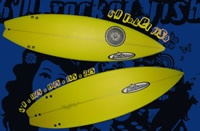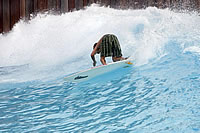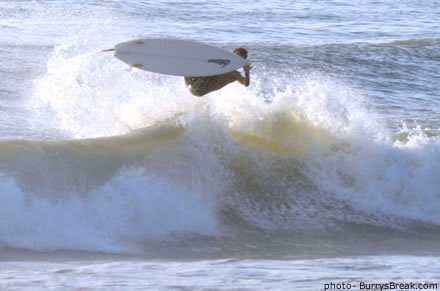Rocketfish evolution: Durability vs. Performance
There is a continuous debate between the supporters of epoxy versus traditional poly fans; one of the leading arguments being a claim that epoxy boards do not have the feel of poly boards. Another issue is durability. While I don’t wish to say that one should stay and the other should go, I do have some empirical evidence, based on my own experiences, which may shine a light on this dark topic.
First off I must clarify what kind of epoxy board I am referring to. My experience is based on a completely hand shaped and hand glassed board made by my shaper, Tom Neilson. We have been working to refine the Rocketfish over a number of years. I have owned three so far and the current outline, plan-shape, rocker and concave are dialled-in so that the board feels like the elusive magic board. Perfect.
I use this board for average beach break conditions. It is a high performance shape with foiled out rails and a triple concave out the tail. I put a lot more hours on this board than any other in my quiver and it gets abused. I do however take exceptional care of all my boards out of the water – from fixing dings right away, to keeping them in a day bag and out of the sun, to safe storage at home.
The three boards in the evolution of the rocketfish are as follows:
 First board –
First board –6’0″ x 19.75″ x 2.25″ Poly Rocketfish
Clark Supergreen blank – 6x6x6 Sun Cure glass job (July 2003 — October 2004)
 Second Board –
Second Board –6’0″ x 19.75 x 2.2″ Poly Rocketfish
Clark Superblue blank – 6x6x6 Sun Cure glass job (October 2004- July 2005)
 Current Board –
Current Board –6’0″ x 19.75″ x 2.15″ Epoxy Rocketfish
2lb EPS blank (Davo) – 6x6x6 Resin Research glass job (July 2005 to present)
As you can see the length and width have remained the same but each board has gotten progressively thinner. Each board is also glassed with two layers of 6-ounce glass on the deck and one on the bottom. Although some would claim that this is too heavy, the weight is negligible and the board will last at least twice as long as a “pro” weight board with a 4-ounce glass job.
I must also point out the difference in Clark blanks used. Supergreen and the Superblue (about 5% lighter than the Supergreen) blanks were Clark’s strongest and heaviest blanks. Next came the Super Light (about 9.5% lighter than the Supergreen) and Ultralight (about 12% lighter than the Supergreen) blanks used for most high performance shortboard applications.
As far as durability goes, the latest epoxy board has suffered the least damage from normal everyday riding. It is not only lighter, but more durable, solving two problems: strength and durability, while having the added benefit of being less toxic overall. The fact that I’m still riding it after a year and a half has really sold me on the EPS/epoxy construction. Not only is the board super dialled in, but by not having to replace it every 6 months, I gain that much more confidence in the board as well as not having to use the resources to re-create another one only to try and emulate the one I’m currently riding. There is a lot to be said for having confidence in your board, knowing how hard you can push it and having it dialled in to varying wave conditions. By keeping the same board under your feet longer it becomes more ingrained in your surfing style and helps your surfing to progress.
 One factor that seems to keep many people from pursuing a more durable board is that they think they will be sacrificing performance. It is clear in the evolution of the my Rocketfish that performance has not been sacrificed; in fact, performance has been the guiding factor in design and has been enhanced with each new board. Both earlier Poly rocketfishes performed extremely well but were ultimately replaced due to fatigue and normal wear. The change in materials has been more of a secondary reason when considering each board but nevertheless, the increased durability and subsequent decrease in the EPS boards’ environmental impact has been an added bonus and something that is weighing more and more in peoples board buying decisions.
One factor that seems to keep many people from pursuing a more durable board is that they think they will be sacrificing performance. It is clear in the evolution of the my Rocketfish that performance has not been sacrificed; in fact, performance has been the guiding factor in design and has been enhanced with each new board. Both earlier Poly rocketfishes performed extremely well but were ultimately replaced due to fatigue and normal wear. The change in materials has been more of a secondary reason when considering each board but nevertheless, the increased durability and subsequent decrease in the EPS boards’ environmental impact has been an added bonus and something that is weighing more and more in peoples board buying decisions.
The current EPS Rocketfish has been in the water for over a year now. I live about three blocks from my local break and making my own hours allows me to surf just about any time that a swell arrives. This means that my board sees more than the average water time and at this point the damage is limited to a few heel dents on the deck. Compare this to numerous rail cracks (a recurring problem with my poly boards), heel/hand/head/knee dents, and a crushed tail on one of the two poly boards (parking lot rash, bad scene).
The point in making this post to Phoresia is twofold – one reason is hopefully shedding a bit of light on the refinement of a surfboard shape and transitioning it to more durable, less toxic materials. The other being that we have featured a lot of wooden surfboards here on Phoresia and we don’t want to send the message that the only way to make a difference is to ditch foam surfboards altogether. While we appreciate the aesthetics and durability of wood boards, we are also realistic in the fact that we know that they are simply out of reach both geographically and monetarily for a lot of surfers. You can work with the materials available to you and make the most of them simply by asking for it. How you spend your money is enough to make a difference.
 Test Pilot: D. Lawless, abusing the epoxy rocketfish
Test Pilot: D. Lawless, abusing the epoxy rocketfish
In the interest of full disclosure, I must admit the R&D of this board was not all for personal edification, I work closely with my shaper to help tune/refine boards and needless to say, this Rocketfish has made it into the model line-up – www.tomneilsonshapes.com
Both Tom and I are really stoked on it. We’re currently working on dialling in some stringerless, vacuum bagged epoxy boards with 17ounces of glass on them and they are coming in under 5 pounds finished weight. Durability AND performance, they aren’t mutually exclusive. Stoked to see where it all leads…
Great Post. My first experience with epoxy was a Stretch Quad, which was entirely the wrong size. In the short time I had it, I found the board to have great durability and performance characteristics (other than it was too big). In choppy waves though, it didn’t have enough weight to feel right. I suspect it was 4×4 over 4 though as it was insanely light, so going 6×6 over 6 sounds like a fix.
If i’m not mistaken, Patagonia’s glass schedule is 4x4x4 over 4×4 and the boards are still light.
I’m going to give EPS/Epoxy another shot for my next shortboard, which ends up getting more water time than my other rides.
Hey Rob, I’m stoked that you’re willing to give EPS/epoxy another shot. If you’ve got a poly shortboard that you like and want to get another out of epoxy, the only advice I would add is to go a little thinner (1/8″ maybe) overall and get the rails foiled out a little more. Otherwise it may feel “corky” and stiff. I’ve head a bunch of explanations why, from floatier eps to stiffer epoxy , but in my experiences I’ve come to the conclusion that the actual board thickness has alot to do with it. Typically with epoxy resin, the glassers will use S-glass, which is stronger, but also a bit stiffer, combined with the epoxy resin. My opinion is that having two identical boards, one poly and one epoxy, the epoxy is going to feel stiffer because of the construction materials. By going a little thinner overall you are greatly increasing the flex characteristics. There is a formula for Beam theory that covers this. Increasing the thickness of an i-beam exponentially increases the stiffness (gross generalization of it, but that’s the concept).
I think I got really lucky with the Epoxy rocketfish, since it was just a refinement of previous boards and the shape had been worked out.
The stringerless board I mentioned in the last paragraph has been giving me fits trying to get the feel right. It’s a new template, new rocker curve, and new construction method. So we are making gross adjustments on each board to try and get it closer to where I want it to feel. It’s got 17oz. on the deck and 15oz. on the bottom so again you have to take into account the construction method for the overall shape. I think the next one is going to be the one though, and I think it’s gonna end up being a hair over 2″ thick x 6’4″ x 18 3/4″ (I’m 6’2″ & 160#) with super foiled out rails. I’ve learned so much just trying to get this latest board dialed in though. I might do a similar write up once I get it all worked out and ridden in some solid waves.
Cool post. I am finishing up the glassing on my first eps/epoxy board. Mostly doing it just b/c i got a super cheap deal on an eps blank. We’ll see how is works.
And thanks to your site i found out about those Staff flops and got some the other day. Very cool flips and just knowing that they are eco friendly is the best.
stoked!